The Delhi Metro has been a boon in my journeys, from zipping to my hotel in Aerocity straight from the airport to quickly getting to Chandni Chowk without having to deal with traffic.
But the Metro can be overwhelming and confusing to figure out at first.
I’ve been traveling India for more than 4 years and aim to visit every state. But one place I often visit is Delhi, and the Metro has been so helpful.
Read on to learn everything you’ll need to know about Delhi’s Metro to have convenient and stress-free travels.
In this post, you’ll learn:
- Delhi Metro’s zones and lines
- Using the Airport Express Line
- How to buy tickets and Smartcards
- Must-visit Metro stations and nearby attractions
- Etiquette and safety tips
- Tips to avoid rush hour
- Using the Metro with other modes of Delhi transport
- Best food stops near Metro stations
- Best markets accessible by Metro
- Art & culture in Delhi Metro stations
- Lesser-known sights near Metro stations
- Nightlife Spots near the Metro Stations
Ready to embark on a metro ride through Delhi? Let’s dive in!
Planning a trip to India at some point? Check out my free ebook to help you save time and money, and avoid headaches. After +4 years in India, I’ve made plenty of mistakes, and this guide shares what I’ve learned so you can have a smoother trip.
Understanding Delhi Metro’s Zones & Lines

Oh, the beautiful spectrum of the Delhi Metro lines! Each one with its own color and places to discover.
Zones and Lines
– Red Line: Takes you from Rithala to Shaheed Sthal. Along the way, don’t miss out on exploring Pitampura’s buzzing markets.
– Yellow Line: This one connects Samaypur Badli to HUDA City Centre, passing through the central areas, including the famous Chhatarpur Temple.
– Green Line: This connects Inderlok and Brigadier Hoshiyar Singh. Bonus: It’s a ride amidst some green patches!
– Violet Line: Kashmiri Gate to Ballabhgarh, it goes past the enchanting Humayun’s Tomb.
– Blue Line: Dwarka to Noida Electronic City/Vaishali. It’s the one I took for a delicious food tour in Chandni Chowk!
– Magenta Line: Janakpuri West to Botanical Garden. A must for a rendezvous with the architectural wonder that is the Lotus Temple.
– Pink Line: Majlis Park to Shiv Vihar. Zipped through this for a lazy Sunday at the Deer Park.
Pro Tip: If you’re looking to explore historical Delhi, the Yellow and Violet lines are your best friends!
This Metro Guide is just one part in my series about Getting Around India. Be sure to read about other transportation forms to best explore this beautiful country.
Navigating the Airport Express Line: A Beginner’s Dive
Ah, so you’ve just landed in Delhi, and you’re itching to start your journey in this vibrant city. But first things first: let’s get you from the airport to the city center efficiently. Enter the Airport Express Line, one of Delhi Metro’s gems.
1. Where to Find the Airport Express Line at the Airport:
As soon as you exit the baggage claim area, follow the signs for the metro. The Delhi Airport Metro Station is strategically located at Terminal 3. If you happen to land at Terminal 1 or 2, don’t fret. Regular shuttle services provided by Delhi Metro will ferry you to Terminal 3, where you can hop onto the Airport Express Line.
2. Destination Points:
The Airport Express Line directly links the Indira Gandhi International Airport and New Delhi City Center. It’ll whisk you away to the New Delhi Railway Station, passing through key stations like Aerocity, Dhaula Kuan, Delhi Aerodrome, and Shivaji Stadium. You can easily connect to other metro lines from the New Delhi Railway Station or hail a cab to your final destination.
3. Cost Comparison:
Now, let’s talk money. A one-way ticket on the Airport Express Line will cost around ₹60 to ₹120, depending on the distance. In contrast, taking a taxi from the airport to the city center can set you back anywhere from ₹500 to ₹1,000, or even more, based on the time of day, traffic, and type of taxi.
Apart from being pocket-friendly, the Airport Express Line is also a time-saver, taking a mere 20 minutes to reach the heart of the city. In Delhi’s infamous traffic, a taxi could take you upwards of an hour (or two, on particularly congested days).
4. Can You Take Luggage On The Delhi Metro?
The Airport Express Line trains are designed with travelers in mind. They have dedicated luggage racks, so you can stash away your bags and travel comfortably. However, just like any other metro around the world, it can get crowded during peak hours, so plan accordingly.
Pro Tip: If you’re staying in Aerocity, get down at the Delhi Aerocity station. It’s a hub of swanky hotels and eateries.
There you have it! The Airport Express Line is not just a mode of transport but a rite of passage for any first-timer in Delhi. Embrace the journey, soak in the sights, and before you know it, you’ll be navigating the metro lines like a local.
Read more: Indian Airport Travel Tips
How To Buy Delhi Metro Cards & Tokens
Navigating the vast expanse of Delhi’s metro system can be a thrilling experience, especially for a first-timer. While the trains themselves are a marvel, understanding the ticketing system is crucial to ensure a smooth ride. Whether you’re in town for a few days or planning an extended stay, knowing your way around metro cards and tokens is the first step.
1. The Two Ticketing Options:
In essence, Delhi Metro offers two primary forms of ticketing: the token and the smart card. Tokens are best for one-off journeys, while the smart card is the frequent traveler’s best friend.
2. Tokens:
– How to Purchase: Walk up to the ticket counters or the Ticket Vending Machines (TVMs) located at every metro station. Select your destination, pay the required amount, and you’re handed a small round token.
– Using the Token: Place it on the entry gate sensor, wait for the green light, and voilà! You’re granted access. Once you reach your destination, drop the token in the slot at the exit gate.
Note: Tokens are only valid on the day of purchase, so ensure you use them timely.
3. Smart Cards:
– How to Purchase: These can be bought at the Customer Care Centers of any metro station. You’ll need to pay a refundable deposit of ₹50 along with the desired credit amount. You can also opt for Tourist Cards, which offer unlimited travel for either one day (₹200) or three days (₹500).
– Using the Card: Simply tap the card on the sensor at the entry gate. The appropriate fare will be automatically deducted when you tap out at your destination.
– Recharging: Run out of balance? No worries. You can recharge the card at any metro station’s Customer Care or through TVMs. They also offer an online recharge option, which is handy when you’re on the go.
Pro-tip: If you’re here for over a day or two, invest in a smart card. Smart Card holders enjoy a 10% discount on fares; during non-peak hours, the discount is a whopping 20%. If you’re going to be traveling frequently, this card is a no-brainer.
4. Fare Charts:
Wondering about the costs? Every metro station showcases a fare chart that lists prices to various destinations. If in doubt, ask the friendly staff at the ticket counter or refer to the Delhi Metro’s official website or mobile app.
Whether you’re using a token or a smart card, the essence is to enjoy the journey. As you zoom through tunnels and over bridges, watch Delhi unfurl in all its chaotic beauty. Embrace the convenience, the hustle, and the rhythm of this city’s lifeline.
Read more: What Can $100 Buy in India?
Must-Visit Metro Stations and Their Surrounding Attractions
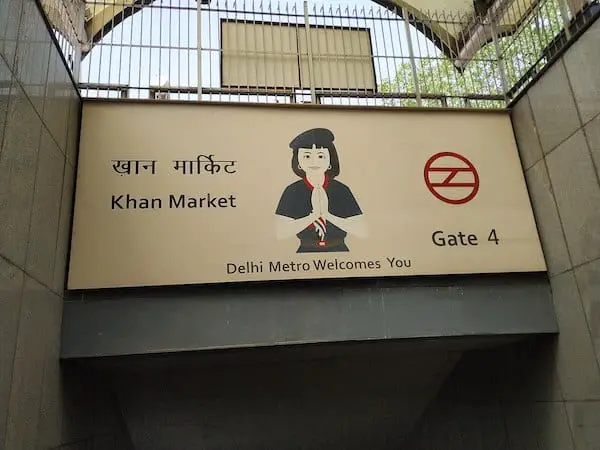
With its millennia-old history and an ever-evolving urban tapestry, Delhi has countless treasures, some of which are conveniently accessible via the metro. As part of your metro adventure, here are some stations that don’t just serve as transit points but open doors to a world of cultural and historical wonders.
1. Rajiv Chowk:
– Metro Line: Yellow and Blue Lines
– Attractions: Connaught Place (often abbreviated as CP) spreads out from Rajiv Chowk at the heart of Delhi. This British-era commercial and recreational vortex brims with shops, restaurants, theaters, and cultural spaces. The Central Park frequently hosts events and the underground Palika Bazaar are mere steps away. Stroll around to feel the pulse of modern Delhi interspersed with colonial charm.
2. Qutub Minar:
– Metro Line: Yellow Line
– Attractions: As the station’s name suggests, the UNESCO World Heritage site of Qutub Minar is nearby. The 73-meter tall tower, dating back to 1193, is an epitome of Indo-Islamic architecture. Explore the surrounding ruins and immerse yourself in a bygone era.
3. Chandni Chowk:
– Metro Line: Yellow Line
– Attractions: The bustling heart of Old Delhi, Chandni Chowk is a sensory overload. From the historic Red Fort to the Jama Masjid, from age-old bazaars to lip-smacking street food, this place is a journey back in time. Dive into the labyrinthine lanes to discover the essence of traditional Delhi.
4. Hauz Khas:
– Metro Line: Yellow Line
– Attractions: Combining the old with the new, Hauz Khas is famed for its village setting dotted with medieval history, and yet, it’s a hub of contemporary culture. Galleries, boutiques, cafes, and the serene Hauz Khas Lake make it a favorite for both locals and tourists.
5. INA:
– Metro Line: Yellow and Pink Lines
– Attractions: Home to Delhi Haat, an open-air food and crafts bazaar. It showcases the richness of Indian handicrafts, cuisines, and cultural performances. A haven for shopaholics and gourmets alike!
6. Akshardham:
– Metro Line: Blue Line
– Attractions: Close to the station lies the magnificent Akshardham Temple. Its intricate carvings, sprawling gardens, and mesmerizing water shows stand as a testament to India’s rich spiritual heritage.
Exploring Delhi through its metro is not just about the convenience; it’s about experiencing the diverse facets of this multifaceted city. Each station can be a starting point of a new story, a new adventure. So, swipe that card or drop that token and let the journey begin!
Read more: Best Time To Visit India’s Most Popular Destinations
Etiquette and Safety Tips For The Delhi Metro
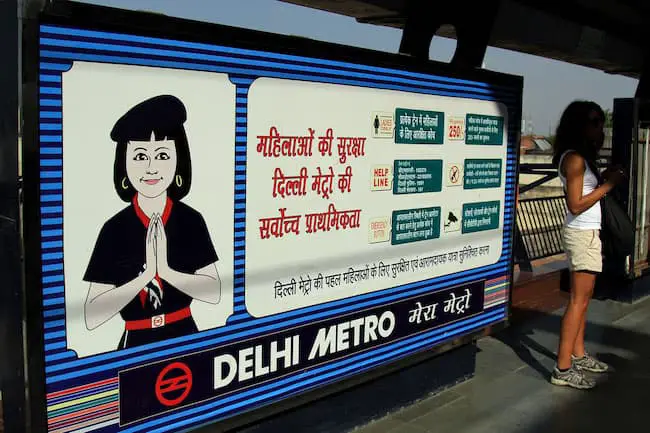
The Delhi Metro, as expansive and efficient as it is, also demands a certain level of etiquette to ensure a comfortable journey for everyone. Whether you’re a seasoned traveler or just dipping your toes into Delhi’s urban sprawl, adhering to these guidelines will make your metro experience seamless and pleasant.
1. Boarding:
– Wait in Line: Stations often have demarcated lines. Always stand behind these while waiting. Let passengers alight before boarding to avoid unnecessary chaos.
– Mind the Gap: Watch your step as there might be a small gap between the train and the platform.
2. Reserved Spaces:
– Ladies’ Compartment: The Delhi Metro reserves a coach exclusively for women. It’s typically the first coach, and while it’s okay for women to travel in other general compartments, men should steer clear of the ladies’ section.
– Seats for Special Needs: Some seats are reserved for the elderly, differently-abled, and pregnant women. Even if they’re vacant, offering them to someone in need is courteous.
3. Personal Space:
– Keep the Volume Down: Remember to keep your volume in check whether you’re listening to music or on a call. The metro is a shared space; let’s keep it harmonious.
– No Littering: Always use trash bins provided at stations. A clean metro is a happy metro!
4. Safety Precautions:
– Hold On: The metro can get crowded, and sudden stops can happen. Always hold onto the railings, especially if you’re standing.
– Beware of Pickpockets: Like any public transport system worldwide, always be mindful of your belongings. Keep bags zipped and wallets in front pockets.
5. Metro Do’s and Don’ts:
– No Eating or Drinking: Refrain from consuming food or drinks within the metro premises.
– Follow Announcements: Always pay attention to in-train and platform announcements for any updates or vital information.
6. Interactions and Help:
– Ask, Don’t Assume: Delhiites are generally amiable. If you’re unsure about something, it’s okay to ask a fellow passenger or metro staff.
– Emergency Button: Each coach has an emergency button. Use it ONLY in genuine emergencies, and metro staff will assist promptly.
Traveling via the Delhi Metro is more than just a commute; it’s an insight into the daily life of the city’s inhabitants. While the trains bridge distances, adhering to these etiquettes bridges cultural gaps, ensuring that everyone enjoys the journey as much as the destination.
Read more: Travel Hacks for India: Learned After 4 Years
Tips to Avoid the Delhi Metro Rush
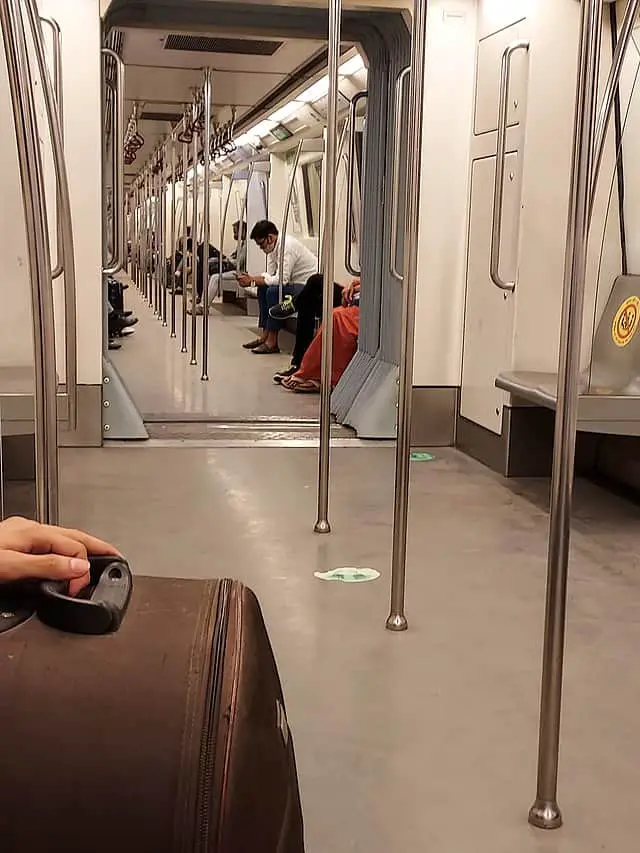
Peak hours in the Delhi Metro can often resemble scenes from adventure movies – bustling platforms, packed coaches, and the race to grab a spot. While the metro system is a marvel of efficiency, the sheer volume of passengers during rush hours can be overwhelming, especially for first-timers. Here’s how to navigate these busy times and make your commute smoother.
1. Understanding the Peak Hours:
– Morning Rush: Typically, 8:30 AM to 10:30 AM on weekdays.
– Evening Flurry: 5:30 PM to 8:30 PM is when most are heading back home or out to unwind.
– Weekends: While slightly less intense than weekday peaks, Sundays can still be busy, especially in tourist-heavy areas.
2. Opt for Off-Peak Travel:
If your schedule is flexible, plan your metro rides outside these peak times. Not only will you enjoy a less crowded journey, but you also get a 20% discount on your smart card during off-peak hours.
3. Know Your Exit:
Before boarding the train, knowing which door will be closest to your exit or transfer line is a good idea. The Delhi Metro app or signage at stations can guide you. Positioning yourself correctly can save you precious minutes and avoid the rush.
4. Be Ready for Boarding:
Have your token or smart card handy before you reach the entry gates. Fumbling in front of the gate can slow down the flow.
5. Travel Light:
If possible, avoid carrying bulky luggage during peak hours. It’s more comfortable for you and courteous to fellow passengers.
6. Stay Alert for Quick Stops:
Trains can halt suddenly. Always hold onto a railing or handle, especially if you’re not seated.
7. Avoid Last-Minute Exits:
If you realize your stop is next, start making your way toward the door a minute or two in advance. Trying to exit from the middle of a crowded coach at the last second can be a challenge.
8. Mind the Platform Screen Doors:
Some metro stations have platform screen doors for added safety. Always stand clear of these and wait for them to slide open before boarding.
9. Opt for Alternate Routes:
If one line is exceptionally crowded, check if another line or a quick interchange can get you to your destination. Sometimes, a slightly longer route can offer a much more relaxed journey.
Despite its rush hours, the Delhi Metro is still one of the most efficient ways to traverse the sprawling city. With a bit of planning, patience, and these tips, you’ll find yourself mastering the metro hustle like a seasoned Delhite in no time.
Using The Metro with Other Modes of Delhi Transport
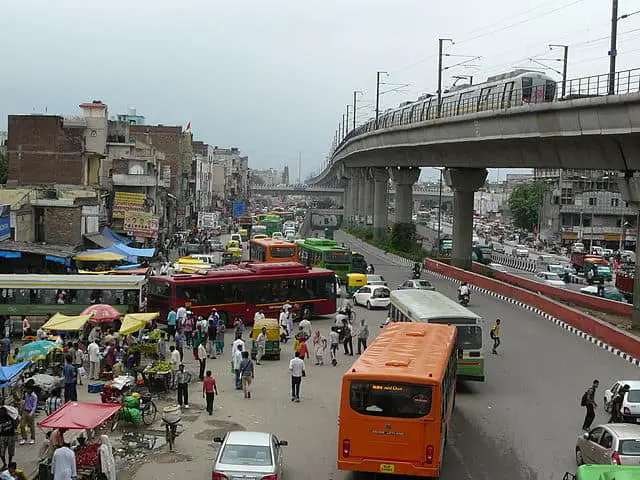
The Delhi Metro, impressive as it is, forms just one part of the city’s vast transportation network. To truly maximize your mobility and experience all that Delhi has to offer, you’ll often find yourself transitioning between the metro and other modes of transport. Here’s how you can effortlessly combine them for a fluid travel experience:
1. Metro to Auto-rickshaw:
– The Three-Wheeled Wonder: Auto-rickshaws, often simply called “autos”, are ubiquitous in Delhi. These green and yellow chariots are perfect for short distances and to reach places that are not directly accessible by metro.
– Tips: Ensure the driver turns on the meter, or agree on a fare before starting the journey. Metro stations usually have a designated auto stand nearby.
Read more: Avoid getting ripped off in a rickshaw with my script for negotiating a fair rate.
2. Cycle Rickshaws & E-Rickshaws:
– Eco-friendly and Easy: Especially prevalent in older parts of Delhi like Chandni Chowk, cycle rickshaws are human-pulled carts, while e-rickshaws are their electric counterparts.
– Tips: They’re best for very short distances. Discuss and decide on the fare upfront.
3. Metro-Feeder Buses:
– Bridge the Gap: Delhi Metro operates feeder bus services at many stations to connect areas not directly touched by the metro.
– Tips: These buses are frequent, and fares are nominal. Keep some change handy, and ask the conductor for assistance if in doubt.
4. Ola & Uber – App-based Cabs:
– Convenient and Comfortable: App-based cab services like Ola and Uber are widely used for a more personalized travel option.
– Tips: Most metro stations have strong mobile network connectivity, so you can book right as you exit. Ensure the pick-up point is clear to avoid confusion.
5. Delhi Transport Corporation (DTC) Buses:
– Widespread Network: DTC buses connect every nook and cranny of Delhi, offering a more in-depth exploration of the city.
– Tips: Buses can be crowded during peak hours. Google Maps can help identify bus routes and numbers. Keep an eye out for AC buses for a more comfortable ride.
6. Renting Bicycles and Scooters:
– Discover at Your Pace: Many areas offer bicycle and scooter rentals, especially around tourist spots. An eco-friendly and healthy way to see the sights!
– Tips: Always wear a helmet if renting a scooter. Familiarize yourself with local traffic rules and be cautious, as Delhi traffic can be unpredictable.
Interlacing the Delhi Metro with these myriad transport options allows you to truly immerse yourself in the city’s rhythm. From the swift efficiency of the metro to the leisurely pace of a cycle rickshaw, each mode offers a unique perspective of Delhi’s multifaceted charm.
Best Food Stops Near Metro Stations
One can’t explore Delhi without savoring its rich culinary heritage. Fortunately, the Delhi Metro offers easy access to some of the city’s most tantalizing treats. The metro has got you covered whether you’re seeking street-food sensations or sophisticated sit-downs. Here’s a guide to the most mouth-watering metro stops.
1. Chandni Chowk (Yellow Line):
– Feast for the Senses: Dive into the world of parathas at ‘Paranthe Wali Gali’, indulge in the legendary ‘Karim’s’ kebabs, or sweeten the deal at ‘Ghantewala Halwai’.
– Tip: Don’t miss the refreshing lassi (yogurt drink) available at various corners.
2. Rajouri Garden (Blue Line):
– Modern Meets Traditional: Here, shopping malls and street vendors live side by side. Explore ‘The California Boulevard’ for international cuisine or local stalls for spicy aloo tikki.
– Tip: Evening walks offer a plethora of snack options.
3. Nehru Place (Violet Line):
– South Indian Delight: While it’s a hub for electronics, Nehru Place hides ‘Saravana Bhavan’ and ‘Sagar Ratna’, two of the best places to get dosas, vadas, and other South Indian dishes.
– Tip: Finish your meal with a filter coffee.
4. INA (Yellow & Pink Lines):
– Dilli Haat’s Diverse Dishes: Beyond handicrafts, Dilli Haat is a melting pot of cuisines from across India. From momos from the North-East to Rajasthan’s dal baati, it’s a culinary carnival.
– Tip: The rotating state stalls provide ever-changing food options, so there’s always something new.
5. Huda City Centre (Yellow Line):
– Gurgaon’s Gourmet Gateway: The metro’s terminus leads to Gurgaon, known for upscale restaurants and cafes. Explore ‘Cyber Hub’ for everything from sushi to biryanis.
– Tip: Many places here offer craft beers, perfect for unwinding after a day of exploration.
6. Kashmere Gate (Red, Yellow, Violet Lines):
– Mughlai Magic: Close to historical sites, the area boasts age-old eateries serving delectable Mughlai cuisine. Seek out ‘Al Jawahar’ or ‘Kuremal Mohan Lal Kulfi Wale’ for a cooling dessert treat.
– Tip: The kebabs here are a must-try, especially during the evening.
Delhi’s food scene is as diverse and dynamic as its history. With each metro stop, you unveil a chapter of the city’s edible story. It’s a fusion of flavors from across the country and even the world. So, while the Delhi Metro may be your ride, let your tastebuds lead the way.
Read more: Must-Try Street Food Dishes in India
Best Markets Accessible by Metro
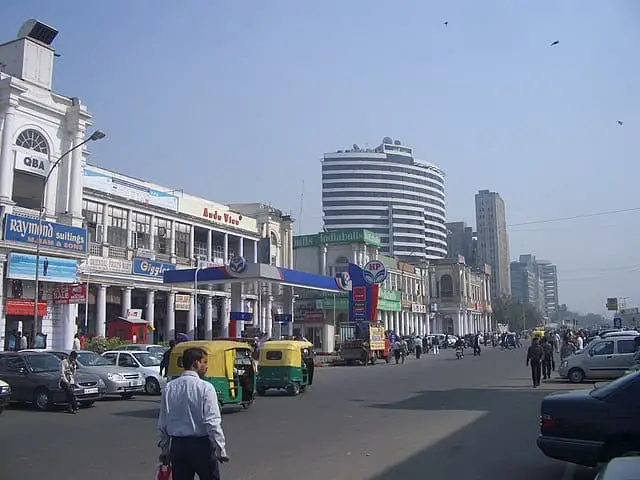
Delhi is a city of history, modernity, and a colorful blend of cultures, offering shopping experiences as varied as its landscape. And the Delhi Metro? It’s your chariot to these bazaars, where you can snag that perfect keepsake. Let’s unravel the shopping secrets close to metro stations, from artisanal crafts to fashionable boutiques.
1. Karol Bagh (Blue Line):
– Diverse Delights: An eclectic mix awaits – jewelry, electronics, apparel, and more. For a classic Delhi souvenir, grab some silver trinkets or embroidered fabrics.
– Tip: Ajmal Khan Road is pedestrianized, so take a leisurely stroll without worrying about traffic.
2. Rajiv Chowk (Blue & Yellow Lines):
– Connaught Place Calling: A historical landmark, its white colonnades host boutiques, bookstores, and branded outlets. Pick up handicrafts from the ‘Central Cottage Industries Emporium’.
– Tip: Dive into the underground ‘Palika Bazaar’ for electronics and affordable souvenirs.
3. Janpath (Violet Line):
– Street Shopping Star: An alley filled with colorful stalls selling jewelry, handicrafts, clothing, and more. A perfect spot for boho-chic souvenirs.
– Tip: Bargaining is an art here. Start at about half the asking price and negotiate from there.
4. Lajpat Nagar (Violet Line):
– Ethnic Enigma: ‘Central Market’ is a haven for traditional wear, textiles, and accessories. Henna artists are also aplenty, offering intricate designs.
– Tip: Try the street food here, especially the ‘paneer tikka’ and ‘golgappas’.
5. Chawri Bazaar (Yellow Line):
– Paper Paradise: Originally a hardware market, it’s now known for wedding invitations and unique paper products. An ideal stop for stationery enthusiasts.
– Tip: Explore the narrow lanes, where you’ll find quaint, age-old shops selling curiosities.
6. Kalkaji Mandir (Violet & Magenta Lines):
– Nehru Place Fabrics: Adjacent to the metro, Nehru Place isn’t just for tech. It’s a treasure trove for textiles, perfect for custom-tailored outfits.
– Tip: Visit early in the day for the best selections and less crowd.
7. Saket (Yellow Line):
– Modern Malls & More: Adjacent to the metro station are malls like ‘Select CITYWALK’, offering high-end brands, boutiques, and crafts from across India.
– Tip: Check out ‘Dilli Haat’ in Saket for handcrafted souvenirs from various states.
Shopping in Delhi is as much about the experience as the purchase. Each market, each stall, tells a story. And with the metro, these narratives are just a ride away. So, pack light and shop heartily!
Read more: Best Souvenirs from India
Art & Culture in Delhi Metro Stations

The Delhi Metro is not just a mode of transport; it’s an ever-evolving canvas celebrating India’s rich tapestry of art, history, and culture. Various stations are adorned with murals, installations, and exhibits that reflect the city’s artistic soul. Here’s your cultural map to the most enchanting metro stops:
1. Jor Bagh (Yellow Line):
– The Heritage Corridor: This station is adorned with artwork showcasing India’s prehistoric era. From ancient cave paintings to tribal art, it’s a visual treat.
– Tip: Pause at the detailed murals, each carrying a snippet of history.
2. Mandi House (Blue & Violet Lines):
– Theatre and Tunes: Celebrating Delhi’s vibrant performing arts scene, this station is decked with motifs from classical dances, instruments, and renowned theatre personalities.
– Tip: Nearby is the actual ‘Mandi House’, a hub for art and culture events. Check out local listings for performances.
3. INA (Yellow & Pink Lines):
– Crafts of India: The station is a visual representation of ‘Dilli Haat’ above ground, showcasing the diverse craft traditions of India, from Kashmir to Kanyakumari.
– Tip: After enjoying the artwork, visit the actual ‘Dilli Haat’ for live performances and workshops.
4. Qutub Minar (Yellow Line):
– Architectural Wonders: As the name suggests, the station offers glimpses of the iconic Qutub Minar and other historical monuments, encapsulating Delhi’s Mughal-era magnificence.
– Tip: The real Qutub Minar is just a short auto ride away – a must-visit!
5. Race Course (Yellow Line):
– India’s Freedom Struggle: The walls here are adorned with poignant moments and key figures from India’s journey to independence.
– Tip: A brief walk leads you to the ‘Indira Gandhi Memorial Museum’, furthering the historical journey.
6. Patel Chowk (Yellow Line):
– Metro Museum: Yes, there’s a museum dedicated to the Delhi Metro itself! It chronicles its journey from conception to realization.
– Tip: The interactive displays make this a fun visit for both kids and adults.
7. Kashmiri Gate (Red, Yellow, Violet Lines):
– Confluence of Cultures: Highlighting the essence of the Old Delhi spirit, murals and exhibits here offer glimpses of the city’s diverse communities and their traditions.
– Tip: Explore nearby areas like ‘Chandni Chowk’ and ‘Red Fort’ for a deep dive into Old Delhi’s charm.
The Delhi Metro is not just about reaching destinations; it’s about the journey, where every station offers a chapter from Delhi’s vast cultural book. So, next time you’re aboard, take a moment to appreciate these art-laden stops, making your commute a cultural excursion.
Lesser-Known Sights Near Metro Stations

Delhi, the grand old city of legends, is brimming with tales waiting to be told. While the iconic landmarks like India Gate and Red Fort are frequented by many, the city hides pockets of serenity and stories often overlooked. Thanks to the Delhi Metro, these lesser-known spots are accessible to those eager to veer off the beaten path. Let’s uncover these secrets!
1. Khan Market (Violet Line):
– Sunder Nursery: A short walk or cycle rickshaw ride from the bustling Khan Market leads to this oasis. Rejuvenated recently, it’s a heritage park with Mughal-era monuments, serene lakes, and lush gardens.
– Tip: Perfect for picnics, early morning jogs, or birdwatching.
2. Green Park (Yellow Line):
– Hauz Khas Village Ruins: While the Hauz Khas Village is known for its hip cafes and boutiques, the adjoining medieval ruins and reservoir offer a picturesque walk.
– Tip: Stay till sunset. The reservoir view is mesmerizing!
3. JLN Stadium (Violet Line):
– Sanskriti Museums: A set of three museums dedicated to Indian textiles, terracotta, and everyday crafts. It’s a quiet enclave offering a deep dive into India’s artisanal heritage.
– Tip: They also offer workshops. Check their schedule!
4. Govind Puri (Violet Line):
– Tughlaqabad Fort: An impressive 14th-century fortification representing the might and ambitions of its founder, Ghiyas-ud-din Tughlaq. While in ruins, its vastness evokes awe.
– Tip: Wear comfy shoes. There’s a lot of ground to cover.
5. Udyog Bhawan (Yellow Line):
– National Gallery of Modern Art: Though not exactly hidden, the nearby India Gate often overshadows it. This gallery houses masterpieces by renowned Indian artists.
– Tip: Their curated walks offer rich insights into the exhibits.
6. Pragati Maidan (Blue Line):
– Purana Qila (Old Fort): With its massive ramparts, boat rides, and a sound & light show, this often-overlooked fort is steeped in history.
– Tip: The Delhi Zoo is adjacent, so you can club the visits.
7. Mayur Vihar Phase-1 (Blue Line):
– Sanjay Van: A sprawling city forest, it offers walking trails amidst dense foliage, dotted with lakes and Mughal-era relics.
– Tip: Carry binoculars. It’s a haven for birdwatchers!
Delhi’s layers of history, culture, and nature are wrapped in a myriad of colors and sounds. While the famous sights command attention, these lesser-known treasures provide a soulful respite. So, let the Delhi Metro be your compass to these hidden wonders, and let every journey be a tale of discovery.
Read more: Offbeat Indian Destinations To Chill
Nightlife Spots Near Metro Stations
The sun might set on Delhi, but the city’s spirit shines even brighter at night. From tranquil lounges to buzzing nightclubs, Delhi’s nightlife has something for everyone. And guess what? The Delhi Metro’s central lines place many of these hotspots within easy reach. So, if you’re planning a night to remember, here’s where the metro can take you:
1. Rajiv Chowk (Blue & Yellow Lines):
– Connaught Place (CP): The heart of Delhi, CP’s Georgian architecture transforms under the night sky. There’s no dearth of choices, from quiet coffee shops to pulsating pubs.
– Tip: ‘Vault Cafe’ offers private vaults for groups, while ‘The Beer Cafe’ boasts an extensive brew menu.
2. Hauz Khas (Yellow Line):
– Hauz Khas Village: A unique blend of modern bars overlooking ancient ruins, this place has a bohemian vibe. The rooftop establishments provide enchanting views of the historic Hauz Khas complex.
– Tip: ‘Social’ offers a fusion of work and play, perfect for both early evenings and late nights.
3. Nehru Place (Violet Line):
– Epicuria Food Mall: More than just a food hub, it’s a vibrant nightlife venue with an array of bars, lounges, and restaurants.
– Tip: ‘Lord of the Drinks’ is renowned for its cocktails, while ‘Flyp@MTV’ often hosts live performances.
4. Akshardham (Blue Line):
– Gardens of Five Senses: Not your conventional nightlife spot, but it’s beautifully lit up in the evenings, offering a tranquil atmosphere amidst themed gardens.
– Tip: The adjacent ‘Fio Country Kitchen and Bar’ is ideal for a romantic dinner.
5. Malviya Nagar (Yellow Line):
– Select CITYWALK Mall, Saket: A short auto ride away, this mall transforms into a nightlife hub with bars, multi-cuisine restaurants, and occasional live shows.
– Tip: ‘The Piano Man Jazz Club’ is a haven for jazz lovers.
6. Sikanderpur (Yellow Line):
– Cyber Hub, Gurugram: A few metro stops away, Cyber Hub is the pulse of Gurugram’s nightlife. It boasts an extensive range of global cuisines, breweries, and bars.
– Tip: ‘Sutra Gastropub’ is known for its vibrant ambiance and DJ nights.
7. Kashmere Gate (Red, Yellow, Violet Lines):
– Majnu Ka Tilla: This Tibetan settlement offers cozy cafes with a distinct Tibetan-Buddhist vibe. Perfect for a serene evening.
– Tip: Try Tibetan delicacies like momos and thukpa at the various eateries.
Delhi unveils a different shade of its multifaceted personality as the evening shades fall. So, if you’re looking to dance the night away, share a quiet meal, or simply soak in the city’s nocturnal vibes, the Delhi Metro is your trusted ally.
Read more: Why is Alcohol Taboo in India?
Wrapping Up Your Delhi Metro Adventures: A First-Timer’s Handbook
For every traveller setting foot in the heart of India, the Delhi Metro emerges as a lifeline, effortlessly weaving through the city’s historic relics and contemporary marvels.
To kickstart your journey, remember the swiftness of the Airport Express Line, bridging the gap between the international skies and the bustling city, not just economically but efficiently. And as you navigate deeper into Delhi’s rhythm, the ease of metro cards and tokens comes to the rescue, offering smooth, hassle-free commutes and the chance to embrace Delhi’s vibrant mosaic of art, culture, and hidden gems.
Equally fascinating is the metro’s dual role as both a connector and a curator. Beyond its prime function as a transportation medium, it’s a silent storyteller, with stations like Jor Bagh and Mandi House narrating tales of India’s rich heritage.
Whether you’re hunting for lesser-known treasures near Khan Market or dancing the night away in Connaught Place, the metro puts the city’s vast expanse within arm’s reach, making every journey an exploration and every stop, a story.
In conclusion, our Delhi Metro Travel Guide is more than just a navigation manual; it’s your passport to experiencing Delhi in its true essence. As a first-timer, let the metro’s tracks guide you, for they lead not just to destinations but to the soul of a city waiting to be discovered. So, bookmark this guide, step aboard, and let the adventures begin – with every metro ride, Delhi unfurls a little more, beckoning with its myriad hues and tales. Safe travels!

